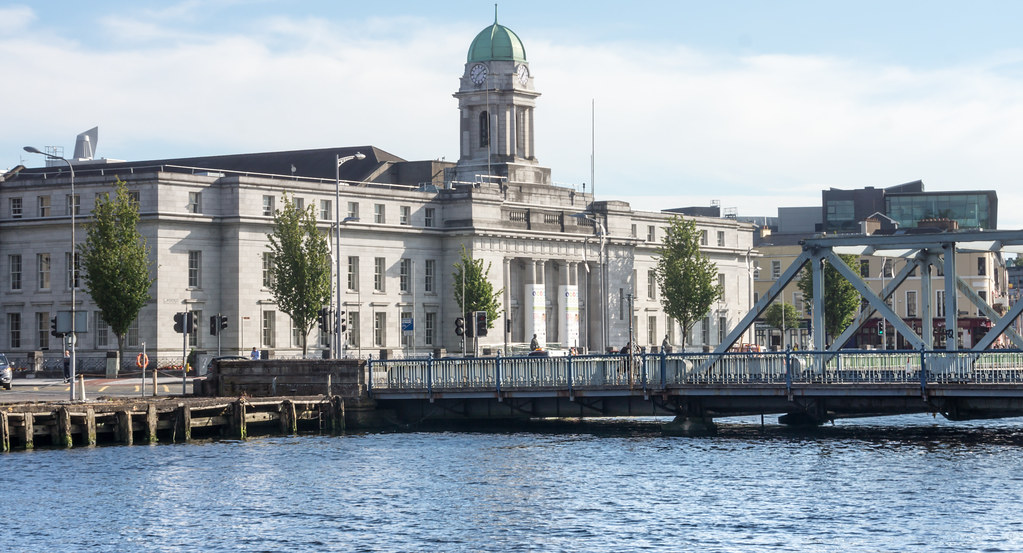CLONTARF BRIDGE IN CORK
Bascule bridges have been in use since ancient times. However, it was not until the adoption of steam power in the 1850s that very long, heavy spans could be moved quickly enough for practical application.
There are two Scherzer rolling lift bascule bridges in Cork and looking at photographs online I have noticed that many people have incorrectly identified the bridges that are featured in their photographs. One bridge is the “Clontarf Bridge” and the other one is the “Brian Boru” bridge.
The Clontarf and Brian Boru bridges are unique in the city’s history, built as they were to accommodate four different forms of transport namely; goods and passenger trains; vehicular traffic, pedestrian traffic and finally to lift into an upright position to accommodate the passage of shipping.
Brian Boru Street was built in conjunction with Brian Boru bridge and for a number of years it was simply known as the New Street.
At this junction, great crowds often accompanied famous people, among them political leaders, in procession to or from Kent railway station. In 1903, King Edward 7th and Queen Alexandria passed by here following their visit to the Cork International Exhibition in Fitzgerald Park.
To the north-east lies Harrington Square, where the famous short-story writer Frank O’Connor lived.
The Clontarf and Brian Boru bridges are unique in the city’s history, built as they were to accommodate four different forms of transport namely; goods and passenger trains; vehicular traffic, pedestrian traffic and finally to lift into an upright position to accommodate the passage of shipping.
Brian Boru Street was built in conjunction with Brian Boru bridge and for a number of years it was simply known as the New Street.
At this junction, great crowds often accompanied famous people, among them political leaders, in procession to or from Kent railway station. In 1903, King Edward 7th and Queen Alexandria passed by here following their visit to the Cork International Exhibition in Fitzgerald Park.
To the north-east lies Harrington Square, where the famous short-story writer Frank O’Connor lived.
SORRY FOR THE DELAY
A bascule bridge (commonly referred to as a drawbridge) is a moveable bridge with a counterweight that continuously balances a span, or "leaf", throughout its upward swing to provide clearance for boat traffic. It may be single or double leafed.
The name comes from the French term for balance scale, which employs the same principle. Bascule bridges are the most common type of movable span because they open quickly and require relatively little energy to operate, while providing the possibility for unlimited vertical clearance for marine traffic.
The name comes from the French term for balance scale, which employs the same principle. Bascule bridges are the most common type of movable span because they open quickly and require relatively little energy to operate, while providing the possibility for unlimited vertical clearance for marine traffic.
There are three types of bascule bridge designs,and counterweights required to balance a bascule's span may be located either above or below the bridge deck.
The fixed-trunnion (sometimes a "Chicago" bascule) rotates around a large axle that raises the span(s). The Chicago bascule name derives from the location where it is widely used, and is a refinement by Joseph Strauss of the fixed-trunnion.
The rolling lift trunnion (sometimes a "Scherzer" rolling lift), raises the span by rolling on a track resembling a rocking chair base. The "Scherzer" rolling lift is a patented refinement by the American engineer William Donald Scherzer.
The rarer Rall type combines rolling lift with longitudinal motion on trunnions when opening. It was patented (1901) by Theodor Rall. One of the few surviving examples is the Broadway Bridge (1913), in Portland, Oregon.
The fixed-trunnion (sometimes a "Chicago" bascule) rotates around a large axle that raises the span(s). The Chicago bascule name derives from the location where it is widely used, and is a refinement by Joseph Strauss of the fixed-trunnion.
The rolling lift trunnion (sometimes a "Scherzer" rolling lift), raises the span by rolling on a track resembling a rocking chair base. The "Scherzer" rolling lift is a patented refinement by the American engineer William Donald Scherzer.
The rarer Rall type combines rolling lift with longitudinal motion on trunnions when opening. It was patented (1901) by Theodor Rall. One of the few surviving examples is the Broadway Bridge (1913), in Portland, Oregon.
THE PHOTO DIARY IS NOT LIMITED TO CORK AS I ONLY VISIT THE CITY ONCE EVERY YEAR AND 2020 MAY BE AN EXCEPTION. I AM BASED IN DUBLIN BUT DURING THE SUMMER MONTHS I VISIT BELFAST, LIMERICK, GALWAY, KILKENNY AND WATERFORD AND USUALLY DEVOTE A WEEK TO PHOTOGRAPHING EACH OF THE CITIES IN QUESTION
You will find links to buy products from Amazon, Google and other partners. If you click on these links, you’ll find that the URL includes a small extra piece of text which identifies that the click came from my websites. This text is an affiliate code, and it means that I get a small percentage of the money you spend if you choose to buy that product, or, in some cases, other products from the site soon after. These affiliate links help pay the costs of producing my websites and ensure that the content is free to you.





